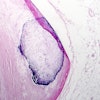Virtual colonoscopy did a better job of measuring polyps than optical colonoscopy, and optimized 2D measurements were slightly more accurate than 3D, according to a just-published study from South Korea.
The researchers sewed polyps made from pig colons into real pig colons in order to prospectively compare radiologists' 2D and 3D VC measurements with those of experienced gastroenterologists armed only with open forceps. Direct measurement of the distances in the phantom served as the reference standard, and the researchers also examined the basis for measurement discrepancy between the two modalities.
"Polyp size is, clinically, the single most important feature of a colorectal polyp because it serves as a rough surrogate of the risk of carcinoma and dictates patient care," wrote Dr. Seong Ho Park, Eugene Choi, and colleagues from the Asan Medical Center and Seoul National University Hospital in Seoul (Radiology online, May 16, 2007).
The measurements affect not only thresholds for removal, but also polyp-matching algorithms in both modalities, they explained. And while both optical colonoscopy and CT colonography (CTC or VC, virtual colonoscopy) produce varying degrees of polyp measurement errors, their reliability and accuracy have never been conclusively compared.
The study measured 86 simulated sessile polyps ranging from 3 to 15 mm that were constructed using pig colons purchased from a slaughterhouse, made as round as possible, and attached to other cleansed pig colons in random size order with the aid of sutures. Vegetable oil substituted for abdominal fat, and the phantom was inflated with air, all packed inside a balloon, Park and his colleagues reported.
CT images were acquired on a 16-detector scanner (Somatom Sensation 16, Siemens Medical Solutions, Erlangen, Germany) with settings of 120 kVp, 50 mAs, and 0.75-mm section thickness, with 1-mm reconstructions at an interval of 0.7 mm. Both 2D and 3D endoluminal measurements were performed on a commercial VC workstation (Advantage 4.2_06, GE Healthcare, Chalfont St. Giles, UK).
Two experienced VC readers performed the measurements, blinded to the specific size of polyps but aware that polyps were placed every 10 cm along the colon wall. "Care was particularly taken to avoid measuring beyond the edge of the polyp during 3D measurements," they wrote.
Two experienced gastroenterologists performed the optical colonoscopy measurements using a video colonoscope immediately after the colons were scanned with CT and the oil mixture removed. Like the radiologists, the gastroenterologists were aware of the polyp placement but not the specific sizes.
The authors reported intraclass correlation coefficients of 0.879 (95% CI, 0.780, 0.930) for optical colonoscopy, 0.979 (95% CI: 0.956, 0.989) for 2D VC, and 0.985 (95% CI: 0.976, 0.990) for 3D VC.
The study found a statistically significant difference among the measurement methods (p < 0.001), demonstrated by mean polyp size and standard deviation, with higher accuracy for the virtual colonoscopy measurements, and slightly higher accuracy for 2D versus 3D VC.
"The mean standard polyp size ± standard deviation for each observer was 76.3% ± 14.7 and 85.3% ± 18.8% for optical colonoscopy, 104.6% ± 11.6 and 101.6% ± 10.1" for 2D VC, and 114% ± 12.4 and 113.4% ± 13.2 for 3D VC.
Discrepancies in the measurements were obtained by subtracting colonoscopy measurements from VC measurements. The discrepancies were not related to polyp size, and "had a statistically significant but weak correlation between the absolute value of the measurement discrepancy and polyp size for 2D CT colonography versus optical colonoscopy (r = 0.184, p = 0.001) and no statistically significant correlation for 3D CT colonography versus optical colonoscopy (r = 0.089, p = 0.098)."
VC had generally better interobserver agreement and less measurement error than optical colonoscopy. The latter tended to underestimate polyp size, perhaps due to the mechanics of the colonoscope, according to the authors.
"Image distortion of the periphery of an endoscopic field that is associated with the wide-angle lens of an endoscope can cause size underestimation," they wrote. "Shortening of the polyp is expected with asymmetric polyps unless the long axis of the polyp is oriented perpendicularly to the viewing direction of the colonoscope. Although efforts were made to maintain close proximity of the forceps to the polyp during measurement, failure to do so by even the slightest margin would in theory lead to some degree of underestimation."
Considering the higher reliability (interobserver agreement) and accuracy of VC, it might be expected to serve as a better guide to the care of patients with polyps, they wrote. While 2D measurements "in an optimized multiplanar reformatted plane" were more accurate than 3D, such measurements are cumbersome and time-consuming, and generally not used in clinical practice.
"Although 3D measurement resulted in a slight overestimation of polyp size in our study, 3D measurement was more accurate than measurement with standard orthogonal 2D planes, mainly because of its instinctive visualization of the long axis of the polyp," Park and colleagues wrote. "Therefore, the 3D technique may be preferred as the primary method for polyp measurement in CT colonographic practice."
For its part, however, 3D has limitations as well. The authors noted that its accuracy may be affected by alternative views such as "virtual dissection," and size may be underestimated when part of the polyp is obscured by fluid or partial collapse of the bowel segment.
Among the limitations, colonoscopy measurements could have been made more accurately with use of a linear calibrated probe, they wrote, and only one VC workstation was used to quantify VC polyp measurements.
Accurate polyp matching is a key to determining VC's sensitivity, the authors noted, and the study results suggest that the commonly used criterion of a 50% margin of error from the polyp size at optical colonoscopy is inappropriate: too strict for smaller polyps, and too generous for larger ones. They recommend a fixed margin-of-error criterion, which would provide more uniform false-mismatch rates for polyps 6 mm and larger.
"Therefore, our results suggest that a discrepancy of -2 to 5 mm ... may be a better size-matching criterion for polyps 6 mm or larger when one uses CT colonography measurement and optical colonoscopic measurement with open biopsy forceps" for polyps ranging from 3-15 mm in diameter, they wrote.
By Eric BarnesAuntMinnie.com staff writer
May 30, 2007
Related Reading
Colon polyps accurately measured using automated and manual 3D techniques, January 5, 2007
2D, 3D primary VC have their own advantages, July 8, 2006
Window levels matter when viewing submerged polyps in VC, July 24, 2006
Reading method, insufflation affect polyp measurements, November 14, 2006
Polyp measurements more accurate in 3D, September 6, 2005
Copyright © 2007 AuntMinnie.com




















